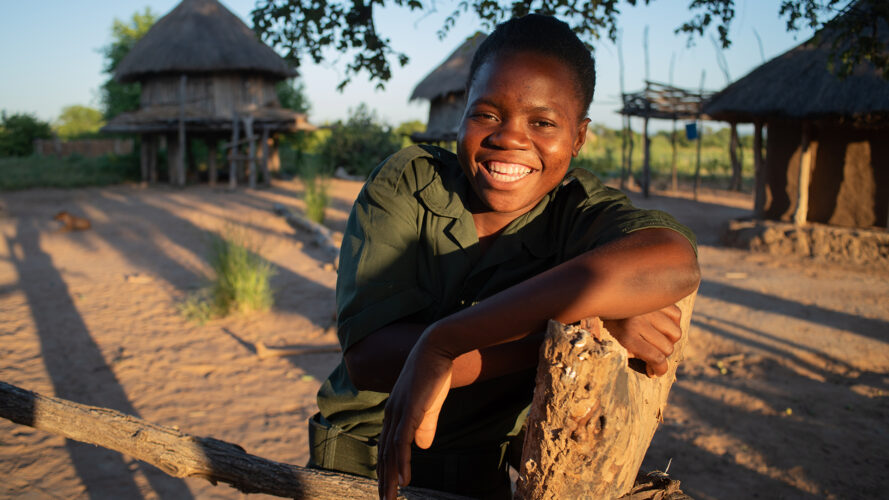Chipo Munsaka explains that her first name means “a gift” in her language. “A gift for conserving wildlife,” the young Zimbabwean adds radiantly. That neatly sums up her commitment and contribution to addressing the growing problem of conflict between humans and wildlife.
Chipo works as a Resource Monitor in northern Zimbabwe with the Mucheni Community Conservancy, which is being established with support from the Sustainable Wildlife Management (SWM) Programme. In addition to wildlife management, the Programme also encourages tree planting and spreads knowledge about the value of preserving them.
Chipo says the job has opened her mind, and she is now setting about “educating the community on how to live with their animals and how to live with their trees.”
Populations of many wildlife species in Zimbabwe have been declining over the last 30 years due to consecutive droughts, habitat loss, poaching, and the sale of wildlife products. At the same time, human–wildlife conflict, whether it’s elephants trampling villagers’ crops or lions and hyenas savaging farmers’ cattle, continues to present multiple challenges for rural communities.
The main approach of the SWM Programme to tackling these issues is supporting community conservancies, which promote improved land use planning and effectiveness of wildlife corridors to reduce conflict and create benefits for communities that coexist with wildlife.
Run by the communities themselves, conservancies provide safe spaces and corridors for wildlife through habitat protection and anti-poaching efforts. They also promote community-led natural resource management, securing land tenure and benefit sharing, while helping communities develop the skills to tap into new sources of income through activities like ecotourism, wildlife-based enterprises and sustainable natural resource harvesting.
The European Union funds the SWM Programme with co-funding from the French Facility for Global Environment and the French Development Agency. It is implemented by the Food and Agriculture Organization of the United Nations (FAO), the Centre for International Forestry Research and World Agroforestry (CIFOR-ICRAF), the Wildlife Conservation Society (WCS), and the French Agricultural Research Centre for International Development (CIRAD). The programme aims to improve wildlife conservation and food security in 15 African, Caribbean, and Pacific countries.
The Mucheni Community Conservancy is part of the Programme’s work in the Kavango Zambezi (KAZA) Transfrontier Conservation area, which straddles five countries (Angola, Botswana, Namibia, Zambia and Zimbabwe), and is implemented in Zimbabwe by CIRAD in coordination with national and local authorities.
After undergoing training at the Munshandike College of Wildlife Management, Chipo and her fellow Resource Monitors are now a driving force in the initiative’s training aspect. They provide communities with innovative and effective ways to reduce conflict with wildlife, such as making and using chilli fences and chilli bricks to ward off elephants.
In the Mucheni Community Conservancy, awareness and knowledge about wildlife management have significantly increased as she and her fellow Resource Monitors have been reporting and responding to incidents of human-wildlife conflict. They have also engaged local communities in an innovative participatory mapping game to help identify and agree on how to tackle wildlife conflict.
Chipo works to promote human-wildlife conflict mitigation measures such as using special enclosures called “mobile bomas”, which are made of canvas or polyester to help keep livestock safe from predators. She and her fellow monitors are also helping restock the area with wildlife and reduce the threats from poaching.
Since 2022, recorded incidents of poaching, encroachment and illegal clearing in forested areas in the Mucheni Conservancy have dropped by 46 percent.
As well as helping her community, Chipo’s income from her work as a Resource Monitor has also benefited her own family. “I am paying school fees for my younger brother. I am using the money that I am getting from my job as a Resource Monitor. The money allowed me to buy goats and a female cow. I gave her a name that is ‘gift’ similar to my name.”
She also says many other women in the community have seen her as a role model for her engagement in a male-dominated field. Chipo is amongst eight female resource monitors supported by the Programme.
“Chipo has demonstrated to us women in this community that it is feasible to participate in male-dominated professions like resource monitoring,” says fellow monitor, Rejoice Ncube.
So whether from a professional or a personal perspective, Chipo’s work offers a positive example of interaction with wildlife and a source of inspiration within the community that surrounds her.
Article from FAO Website

